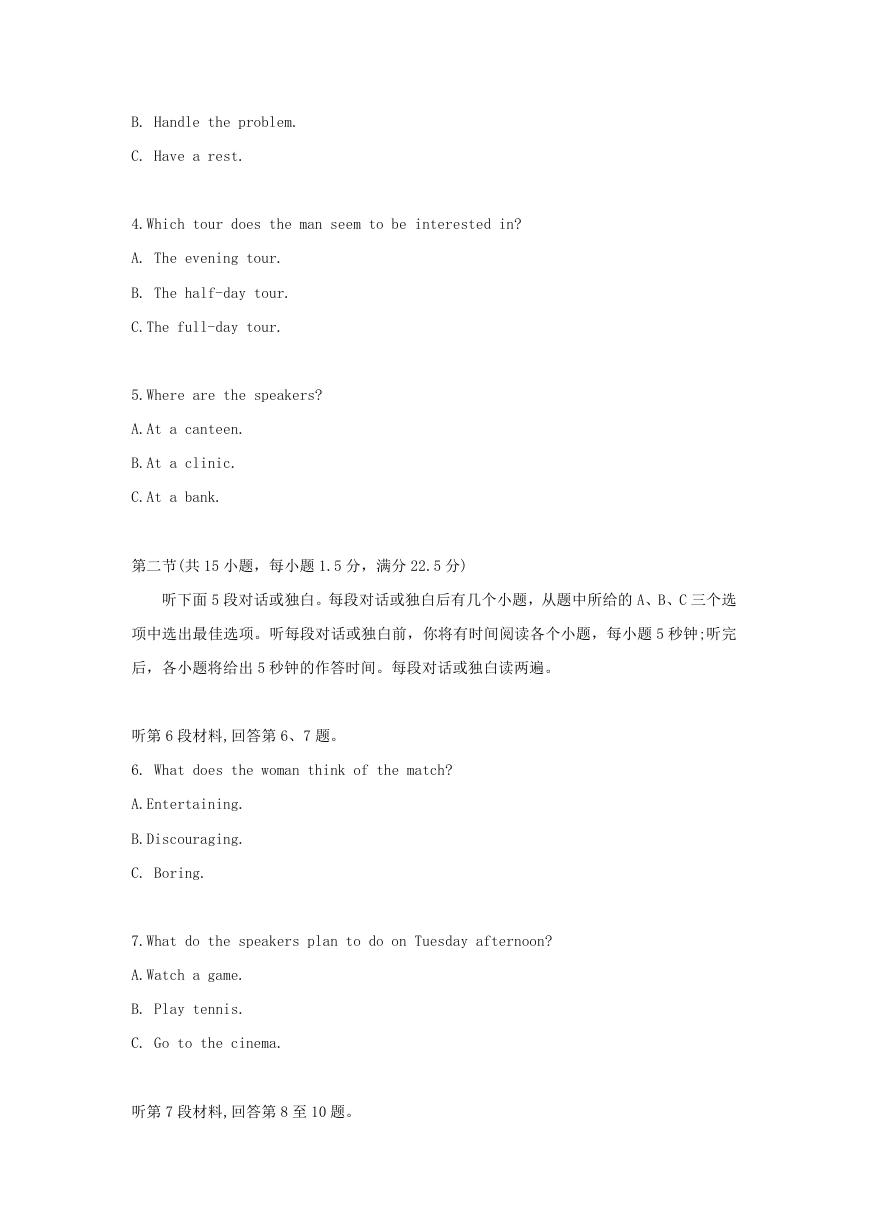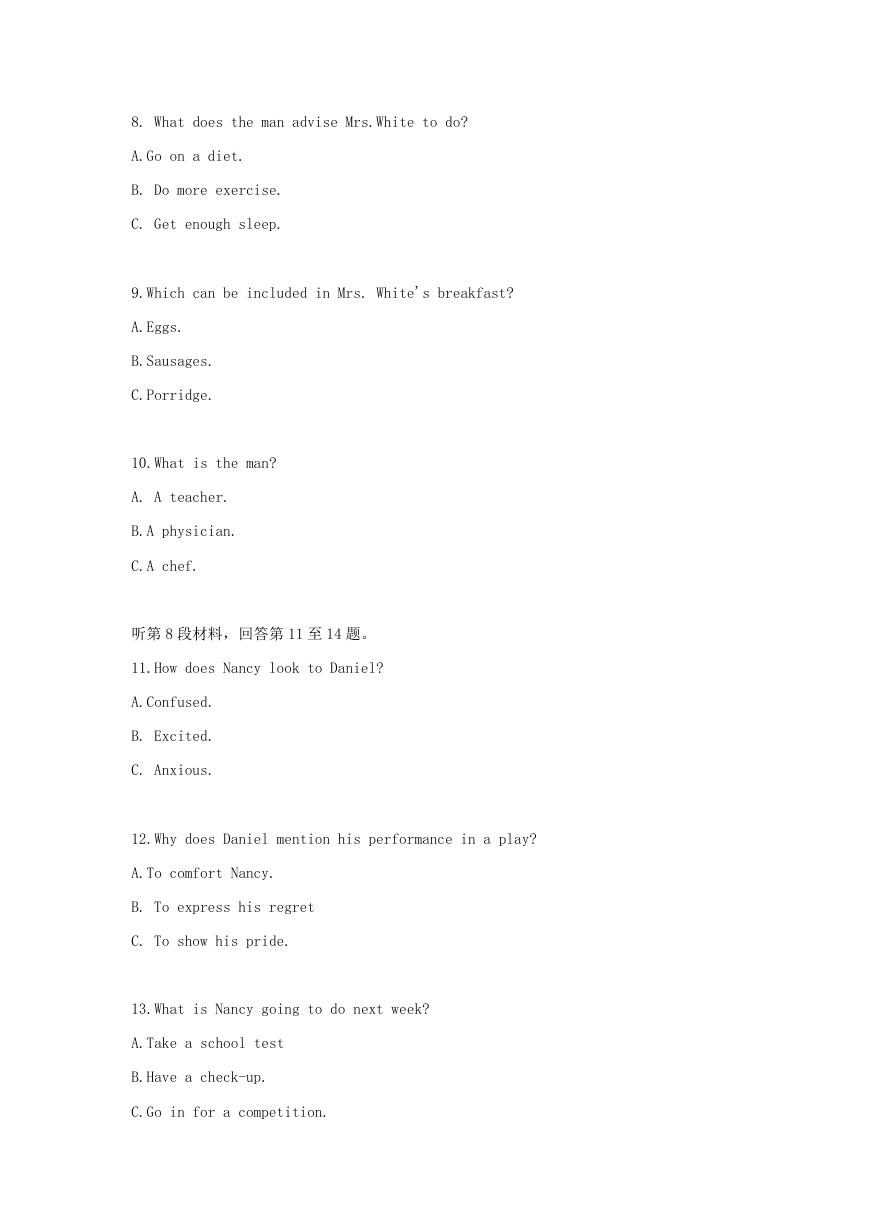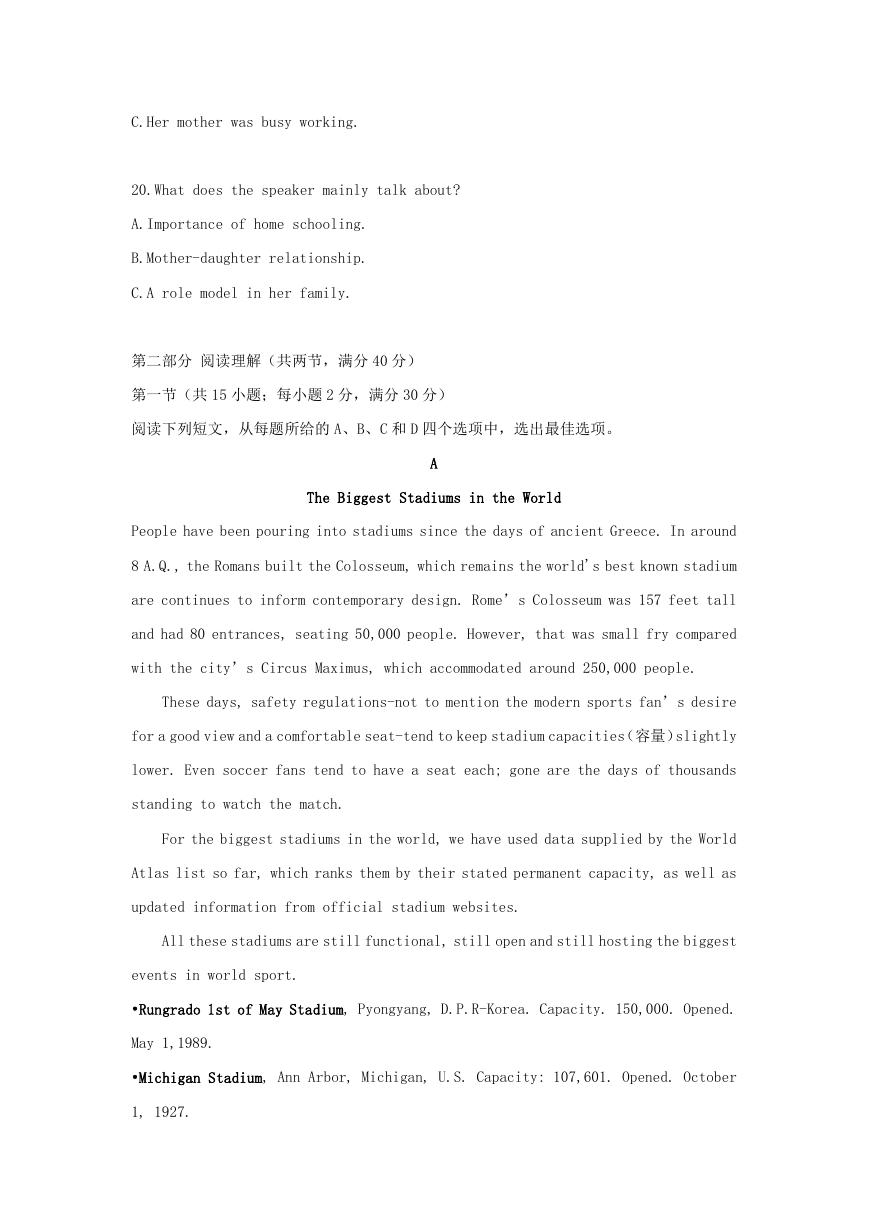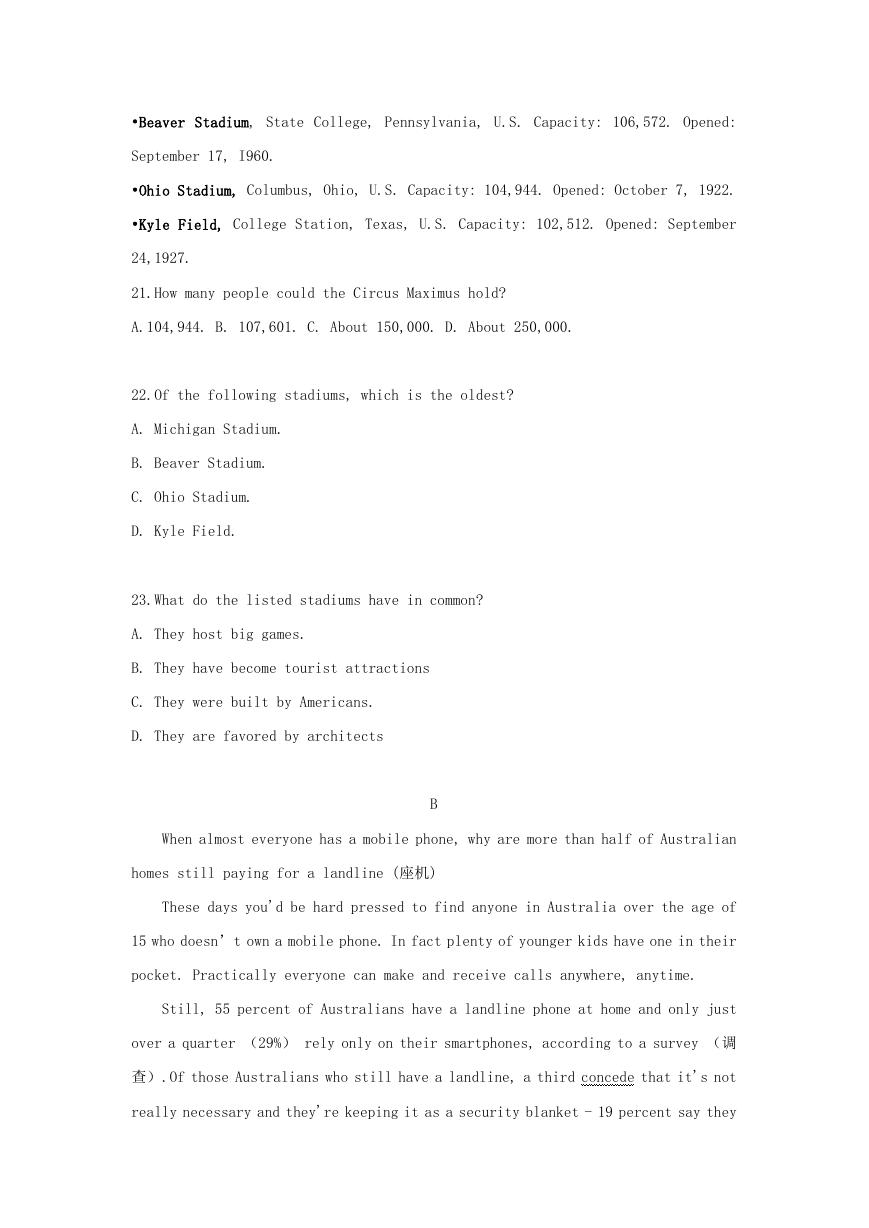2021 年新疆高考英语真题及答案
注意事项:
1.答卷前,考生务必将自己的姓名、准考证号填写在答题卡上。
2.回答选择题时,选出每小题答案后,用铅笔把答题卡上对应题目的答案标号涂黑。如需
改动,用橡皮擦干净后,再选涂其他答案标号。回答非选择题时,将答案写在答题卡上,写
在本试卷上无效。
3.考试结束后,将本试卷和答题卡一并交回。
第一部 分听力(共两节,满分 30 分)
做题时,先将答案标在试卷上。录音内容结束后,你将有两分钟的时间将试卷上的答案转涂
到答题卡上。
第一节(共 5 小题:每小题 1.5 分,满分 7.5 分)
听下面 5 段对话。每段对话后有一个小题,从题中所给的 A、B、C 三个选项中选出最佳选项。
听完每段对话后,你都有 10 秒钟的时间来回答有关小题和阅读下一小题。
每段对话仅读一遍。
例:How much is the shirt?
A. £19.15.
答案是 C。
B.£9.18.
C. £9.15.
1.What is the man doing?
A. Asking the way.
B.Giving directions.
C. Correcting a mistake.
2.What dress size does the woman want?
A.8.
B.10.
C.12.
3.What is the woman likely to do?
A. Make a phone call.
�
B. Handle the problem.
C. Have a rest.
4.Which tour does the man seem to be interested in?
A. The evening tour.
B. The half-day tour.
C.The full-day tour.
5.Where are the speakers?
A.At a canteen.
B.At a clinic.
C.At a bank.
第二节(共 15 小题,每小题 1.5 分,满分 22.5 分)
听下面 5 段对话或独白。每段对话或独白后有几个小题,从题中所给的 A、B、C 三个选
项中选出最佳选项。听每段对话或独白前,你将有时间阅读各个小题,每小题 5 秒钟;听完
后,各小题将给出 5 秒钟的作答时间。每段对话或独白读两遍。
听第 6 段材料,回答第 6、7 题。
6. What does the woman think of the match?
A.Entertaining.
B.Discouraging.
C. Boring.
7.What do the speakers plan to do on Tuesday afternoon?
A.Watch a game.
B. Play tennis.
C. Go to the cinema.
听第 7 段材料,回答第 8 至 10 题。
�
8. What does the man advise Mrs.White to do?
A.Go on a diet.
B. Do more exercise.
C. Get enough sleep.
9.Which can be included in Mrs. White's breakfast?
A.Eggs.
B.Sausages.
C.Porridge.
10.What is the man?
A. A teacher.
B.A physician.
C.A chef.
听第 8 段材料,回答第 11 至 14 题。
11.How does Nancy look to Daniel?
A.Confused.
B. Excited.
C. Anxious.
12.Why does Daniel mention his performance in a play?
A.To comfort Nancy.
B. To express his regret
C. To show his pride.
13.What is Nancy going to do next week?
A.Take a school test
B.Have a check-up.
C.Go in for a competition.
�
14.What does Daniel offer to do for Nancy?
A.Rewrite her lines.
B.Drive her to the theatre.
C.Help her with the practice.
听第 9 段材料,回答第 15 至 17 题。
15.What was Prof. Stone's grandfather afraid of?
A.Leaving his home.
B.Parting from his son.
C.Taking early retirement.
16.What does old age mean to many elderly Americans?
A.Lack of moral support.
B. Loss of self-worth.
C. Change of living habits.
17.What will Prof Stone talk about next concerning elderly people?
A.Public services they ask for.
B.Health care available to them.
C.Contributions they can make.
听第 10 段材料,回答第 18 至 20 题。
18.What does the speaker's mother want her to be?
A.A confident person.
B. A warm-hearted person.
C. A humorous person.
19.Why did the speaker feel lonely in her childhood?
A.She often traveled by herself
B.Her family moved frequently.
�
C.Her mother was busy working.
20.What does the speaker mainly talk about?
A.Importance of home schooling.
B.Mother-daughter relationship.
C.A role model in her family.
第二部分 阅读理解(共两节,满分 40 分)
第一节(共 15 小题;每小题 2 分,满分 30 分)
阅读下列短文,从每题所给的 A、B、C 和 D 四个选项中,选出最佳选项。
A
The Biggest Stadiums in the World
People have been pouring into stadiums since the days of ancient Greece. In around
8 A.Q., the Romans built the Colosseum, which remains the world's best known stadium
are continues to inform contemporary design. Rome’s Colosseum was 157 feet tall
and had 80 entrances, seating 50,000 people. However, that was small fry compared
with the city’s Circus Maximus, which accommodated around 250,000 people.
These days, safety regulations-not to mention the modern sports fan’s desire
for a good view and a comfortable seat-tend to keep stadium capacities(容量)slightly
lower. Even soccer fans tend to have a seat each; gone are the days of thousands
standing to watch the match.
For the biggest stadiums in the world, we have used data supplied by the World
Atlas list so far, which ranks them by their stated permanent capacity, as well as
updated information from official stadium websites.
All these stadiums are still functional, still open and still hosting the biggest
events in world sport.
•Rungrado 1st of May Stadium, Pyongyang, D.P.R-Korea. Capacity. 150,000. Opened.
May 1,1989.
•Michigan Stadium, Ann Arbor, Michigan, U.S. Capacity: 107,601. Opened. October
1, 1927.
�
•Beaver Stadium, State College, Pennsylvania, U.S. Capacity: 106,572. Opened:
September 17, I960.
•Ohio Stadium, Columbus, Ohio, U.S. Capacity: 104,944. Opened: October 7, 1922.
•Kyle Field, College Station, Texas, U.S. Capacity: 102,512. Opened: September
24,1927.
21.How many people could the Circus Maximus hold?
A.104,944. B. 107,601. C. About 150,000. D. About 250,000.
22.Of the following stadiums, which is the oldest?
A. Michigan Stadium.
B. Beaver Stadium.
C. Ohio Stadium.
D. Kyle Field.
23.What do the listed stadiums have in common?
A. They host big games.
B. They have become tourist attractions
C. They were built by Americans.
D. They are favored by architects
B
When almost everyone has a mobile phone, why are more than half of Australian
homes still paying for a landline (座机)
These days you'd be hard pressed to find anyone in Australia over the age of
15 who doesn’t own a mobile phone. In fact plenty of younger kids have one in their
pocket. Practically everyone can make and receive calls anywhere, anytime.
Still, 55 percent of Australians have a landline phone at home and only just
over a quarter (29%) rely only on their smartphones, according to a survey (调
查).Of those Australians who still have a landline, a third concede that it's not
really necessary and they're keeping it as a security blanket - 19 percent say they
�
never use it while a further 13 percent keep it in case of emergencies. I think my
home falls into that category.
More than half of Australian homes are still choosing to stick with their home
phone. Age is naturally a factor (因素)-only 58 percent of Generation Ys still
use landlines now and then, compared to 84 percent of Baby Boomers who've perhaps
had the same home number for 50 years. Age isn't the only factor; I'd say it's also
to do with the makeup of your household.
Generation Xers with young families, like my wife and I, can still find it
convenient to have a home phone rather than providing a mobile phone for every family
member. That said, to be honest the only people who ever ring our home phone are
our Baby Boomers parents, to the point where we play a game and guess who is calling
before we pick up the phone (using Caller ID would take the fun out of it).
How attached are you to your landline? How long until they go the way of gas
street lamps and morning milk deliveries?
24. What does paragraph 2 mainly tell us about mobile phones?
A. Their target users.
B. Their wide popularity.
C. Their major functions.
D. Their complex design.
25. What does the underlined word "concede" in paragraph 3 mean?
A. Admit.
B. Argue.
C. Remember.
D. Remark.
26. What can we say about Baby Boomers?
A. They like smartphone games.
B. They enjoy guessing callers’ identity.
C. They keep using landline phones.
�
D. They are attached to their family.
27. What can be inferred about the landline from the last paragraph?
A. It remains a family necessity.
B. It will fall out of use some day.
C. It may increase daily expenses.
D. It is as important as the gas light.
C
You’ve heard that plastic is polluting the oceans—between 4.8 and 12.7 million
tonnes enter ocean ecosystems every year. But does one plastic straw or cup really
make a difference? Artist Benjamin Von Wong wants you to know that it does. He builds
massive sculptures out of plastic garbage, foreing viewers to re-examine their
relationship to single-use plastic products.
At the beginning of the year, the artist built a piece called“Strawpocalypse,”
a pair of 10-foot-tall plastic waves, frozen mid-crash. Made of 168,000 plastic
straws collected from several volunteer beach cleanups, the sculpture made its first
appearance at the Estella Place shopping center in Ho Chi Minh City, Vietnam.
Just 9% of global plastic waste is recycled. Plastic straws are by no means the
biggest source (来源)of plastic pollution, but they’ve recently come under fire
because most people don’t need them to drink with and, because of their small size
and weight, they cannot be recycled. Every straw that' s part of Von Wong's artwork
likely came from a drink that someone used for only a few minutes. Once the drink
is gone, the straw will take centuries to disappear.
In a piece from 2018, Von Wong wanted to illustrate (说明) a specific statistic:
Every 60 seconds, a truckload's worth of plastic enters the ocean. For this work,
titled "Truckload of Plastic, "Von Wong and a group of volunteers collected more
than 10,000 pieces of plastic, which were then tied together to look like they’d
been dumped(倾倒)from a truck all at once.
Von Wong hopes that his work will also help pressure big companies to reduce
�
















 2023年江西萍乡中考道德与法治真题及答案.doc
2023年江西萍乡中考道德与法治真题及答案.doc 2012年重庆南川中考生物真题及答案.doc
2012年重庆南川中考生物真题及答案.doc 2013年江西师范大学地理学综合及文艺理论基础考研真题.doc
2013年江西师范大学地理学综合及文艺理论基础考研真题.doc 2020年四川甘孜小升初语文真题及答案I卷.doc
2020年四川甘孜小升初语文真题及答案I卷.doc 2020年注册岩土工程师专业基础考试真题及答案.doc
2020年注册岩土工程师专业基础考试真题及答案.doc 2023-2024学年福建省厦门市九年级上学期数学月考试题及答案.doc
2023-2024学年福建省厦门市九年级上学期数学月考试题及答案.doc 2021-2022学年辽宁省沈阳市大东区九年级上学期语文期末试题及答案.doc
2021-2022学年辽宁省沈阳市大东区九年级上学期语文期末试题及答案.doc 2022-2023学年北京东城区初三第一学期物理期末试卷及答案.doc
2022-2023学年北京东城区初三第一学期物理期末试卷及答案.doc 2018上半年江西教师资格初中地理学科知识与教学能力真题及答案.doc
2018上半年江西教师资格初中地理学科知识与教学能力真题及答案.doc 2012年河北国家公务员申论考试真题及答案-省级.doc
2012年河北国家公务员申论考试真题及答案-省级.doc 2020-2021学年江苏省扬州市江都区邵樊片九年级上学期数学第一次质量检测试题及答案.doc
2020-2021学年江苏省扬州市江都区邵樊片九年级上学期数学第一次质量检测试题及答案.doc 2022下半年黑龙江教师资格证中学综合素质真题及答案.doc
2022下半年黑龙江教师资格证中学综合素质真题及答案.doc